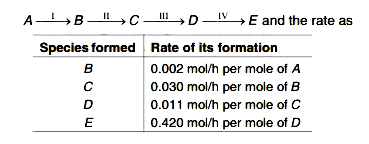The hypothetical reaction is catalyzed by E as indicated in the possible mechanism below. ltbr> Step 1: (fast)
Step 2: (slow)
Step 3: (fast)
Which rate law best agrees with this mechanism?
Rate
Rate=
Rate
Rate
The correct Answer is:C
Step by step video, text & image solution for The hypothetical reaction 2A +Brarr C+D is catalyzed by E as indicated in the possible mechanism below. ltbr. Step 1: A+E hArr AE" "(fast) Step 2: AE + A rarr A_(2)+E " " (slow) Step 3: A_(2) +B rarr C +D " " (fast) Which rate law best agrees with this mechanism? by Chemistry experts to help you in doubts & scoring excellent marks in Class 12 exams.
Updated on:21/07/2023Topper's Solved these Questions
- CHEMICAL KINETICSBook:GRB PUBLICATIONChapter:CHEMICAL KINETICSExercise:compllcatio in first order reactions
Explore 17 Videos
- CHEMICAL KINETICSBook:GRB PUBLICATIONChapter:CHEMICAL KINETICSExercise:Nuclear Chemistry
Explore 63 Videos
- CHEMICAL KINETICSBook:GRB PUBLICATIONChapter:CHEMICAL KINETICSExercise:F. Effect of Temperature and Catalyst
Explore 92 Videos
- CHEMICAL BONDING-IBook:GRB PUBLICATIONChapter:CHEMICAL BONDING-IExercise:Subjective Type
Explore 120 Videos
- COORDINATION COMPOUNDSBook:GRB PUBLICATIONChapter:COORDINATION COMPOUNDSExercise:SBJECTIVE TYPE
Explore 98 Videos
Similar Questions
Knowledge Check
Given the hypothetical reaction mechanism
 E and the rate as The rate determining step is Astep IBstep IICstep IIIDstep IV
E and the rate as The rate determining step is Astep IBstep IICstep IIIDstep IVThe mechanism of the reaction: A+2B+C→D is
(step 1) (fast) equilibrium A+B⇔X
(step 2)(slow) X+C→Y
(step 3) (fast) Y+B→D
Which rate law is correct ?Av=k[C]Bv–=k––[A][B]2[C]Cv=k[A][B][C]Dv=k[D]A reaction A→B , involes following mechanism :
Step1 : Ak1−−→B (fast)
Step2 : Bk2−−→C (slow)
Step3: Ck3−−→D (fast)
The rate law of the reaction may be given as :Arate=k1[A]Brate=k2[B]Crate=k3[C]Drate=k1k2k3[B][C]
The mechanism for the overall reaction is
A2+B→C
A2→2A (slow)
2A+B→X (fast)
If a catalyst D changes the mechanism to
A2+D→A2D (slow)
A2D⇒2A+D (fast)
2A+B→C (fast)
Which is the rate expresison for the reaction with and without a catalyst ?
View Solution2A+B→D+E, for the reaction proposed mechanism A+B→C+D (slow), A+C→E (fast). The rate law expression for the reaction is
View SolutionConsider the hypothetical reaction A+2B→AB2
it follows rate law, rate=k[A][B] hence, rate determining step is
View SolutionThe chemical reaction, 2O3→3O2 proceeds as follows
Step1 : O3⇔O2+O …(fast)
Step 2: O+O3→2O2 …(slow)
The rate law expression should be
View SolutionA hypothetical reaction A2+B2→2AB follows the mechanism as given below:
A2⇔A+A(fast)
A+B2→AB+B (slow)
A+B→AB (fast)
The order of the overall reaction is
View Solution